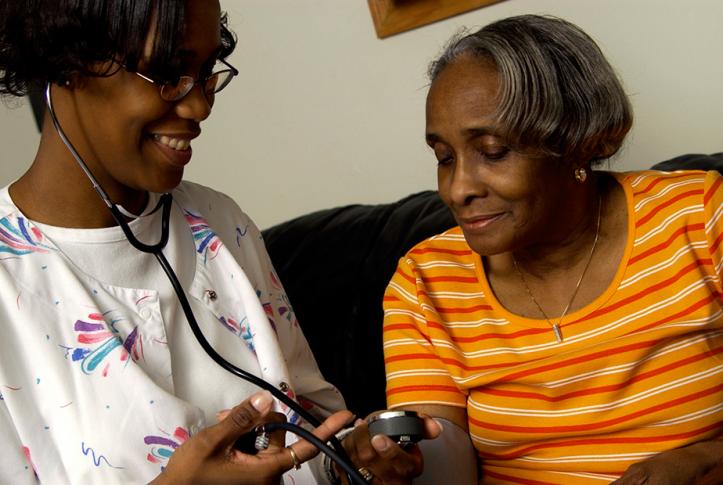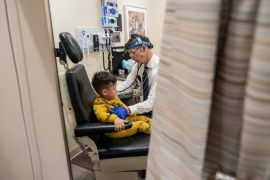

Abstract
A new survey from The Kaiser Family Foundation and The Commonwealth Fund asked primary care providers—physicians, nurse practitioners, and physician assistants—about their views of and experiences with the Affordable Care Act (ACA) and other changes in health care delivery and payment, as well as their thoughts on the future of primary care. In this first brief based on the survey, many providers reported seeing an increased number of patients since the coverage expansions went into effect, but not an accompanying compromise in quality of care. A large majority of primary care providers are satisfied with their medical practice, but a substantial percentage of physicians expressed pessimism about the future of primary care. Similar to the population overall, providers’ views of the ACA are divided along party lines. A second brief will report on providers’ reactions to other changes occurring in primary care delivery and payment.
OVERVIEW
The Affordable Care Act (ACA) expanded health insurance coverage to millions of Americans, mainly by providing subsidies for the purchase of private coverage in new insurance marketplaces and by broadening eligibility for Medicaid. Estimates of the total decline in the uninsured vary, but the U.S. Department of Health and Human Services recently estimated that about 16 million uninsured people have gained insurance since the law’s coverage provisions took effect.1 How is this coverage expansion affecting health care providers, particularly those in primary care who are on the front lines of the nation’s health care delivery system?
Using data from the Kaiser Family Foundation/Commonwealth Fund 2015 National Survey of Primary Care Providers, this brief examines the experiences of primary care providers under the first year of ACA coverage expansions, focusing on changes since January 2014 to their patient populations and ability to provide quality care and meet patient demand. It also explores providers’ opinions about the law. The survey, conducted by mail and online from January 5 through March 30, 2015, is based on a nationally representative sample of 1,624 primary care physicians and a separate nationally representative sample of 525 midlevel clinicians (nurse practitioners and physician assistants) working in primary care practices.
Overall, 59 percent of physicians and 64 percent of nurse practitioners and physician assistants reported that since the ACA coverage expansions took effect, they have seen either an increase in the number of Medicaid patients they serve or an increase in patients who were previously uninsured. Providers working in community clinics and those in states that expanded their Medicaid programs are more likely to report experiencing these increases. Providers reported absorbing these increases without a negative impact on patient care. Most providers said their ability to provide high-quality care to all patients has not changed since January 2014 whether or not they have experienced increases in their Medicaid or newly insured patient populations.
Primary care providers do not appear to be closing their practices to new patients in response to coverage expansions. Comparisons of the current survey with a similar study conducted in 2012 find that the reported rate of new patient acceptance among primary care physicians has declined slightly (89% to 83%), but the share accepting new Medicaid patients remains about the same at 50 percent.
However, many providers feel that the amount of time they have with each patient and the time they spend on insurance administration issues have gotten worse. Surveys conducted before the ACA reforms took effect suggest that these are issues that have concerned providers since long before health reform was enacted.
The survey points to a disconnect between providers’ reported experiences and their opinions about the law. Similar to the population overall, physicians’ views of the ACA are divided along partisan lines. Providers who are Democrats are more likely to report a positive rather than a negative impact of the ACA by a three-to-one margin; Republican providers lean in the opposite direction by seven-to-one.
Despite these sharply divided opinions, a large majority of primary care providers— Democrats and Republicans alike—are satisfied with their medical practices. In fact, satisfaction levels are slightly higher than what was reported by primary care physicians in 2012, before the ACA. Still, a sense of pessimism persists among physicians in particular, as nearly half said they would not advise a young person to pursue a career in primary care.
CHANGES IN PATIENT POPULATION AND PRACTICE CAPACITY AFTER THE ACA COVERAGE EXPANSIONS
Primary Care Providers See Increases in Newly Insured and Medicaid Patients
Since the major coverage provisions of the ACA took effect in January 2014, many primary care providers (44% of physicians, 54% percent of nurse practitioners and physician assistants) reported an increase in the overall number of patients they see (Exhibit 1). Younger providers are significantly more likely than older providers to report an increase in patient volume, suggesting that at least some of the change may be attributable to those who are still building and growing their practices (data not shown).
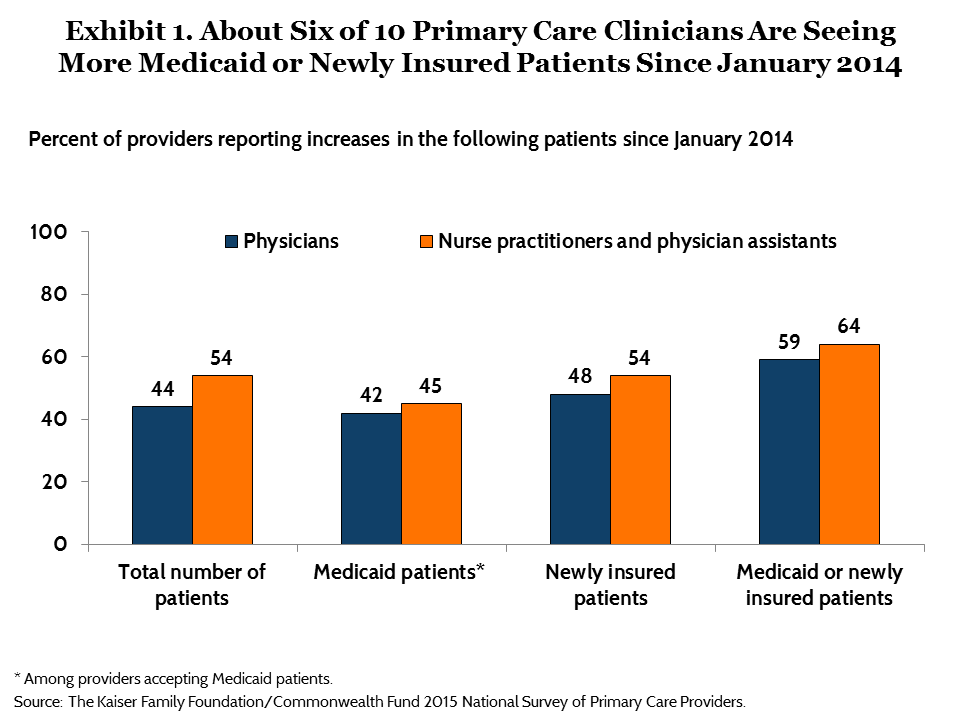
Approximately half of providers (48% of physicians, 54% of midlevel clinicians) have seen an increase since January 2014 in the number of patients who are newly insured. Among physicians working in community health centers, seven of 10 saw an increase (Table 1). Among providers who accept Medicaid, more than four of 10 (42% of physicians, 45% of midlevel clinicians) reported an increased number of Medicaid patients. In states that expanded Medicaid under the ACA, about half of providers reported seeing an increase in Medicaid patients, compared with fewer than four of 10 of those working in states that opted out of the expansion (Table 2). Overall, 59 percent of physicians and 64 percent of nurse practitioners and physician assistants reported seeing either an increase in patients covered by Medicaid or an increase in patients who were previously uninsured.
Slightly less than four of 10 physicians (37%) and more than four of 10 midlevel providers (44%) said the number of patients they treat with chronic illnesses has increased since January 2014. However, the majority of providers said this number has remained about the same (Table 1). The share reporting an increase in chronically ill patients is fairly evenly distributed across different types of providers. The percentage is not significantly higher among physicians working in community health clinics or those treating mostly low-income patients, which are the groups mostly likely to have gained coverage under the ACA.
Despite Patient Increases, Primary Care Providers Able to Deliver High-Quality Care
Despite these reported changes in their patient populations, majorities of primary care providers reported no change since January 2014 in their ability to provide high-quality care to all patients or in their patients’ satisfaction and experiences with care (Exhibit 2). About one of five providers said things have improved; a similar share said things have gotten worse. Providers are somewhat less sanguine about their practices’ ability to recruit and retain clinical staff (Table 3). About half said this has not changed since January 2014, but about a third said it has gotten worse. Fewer than one of 10 said it has improved.
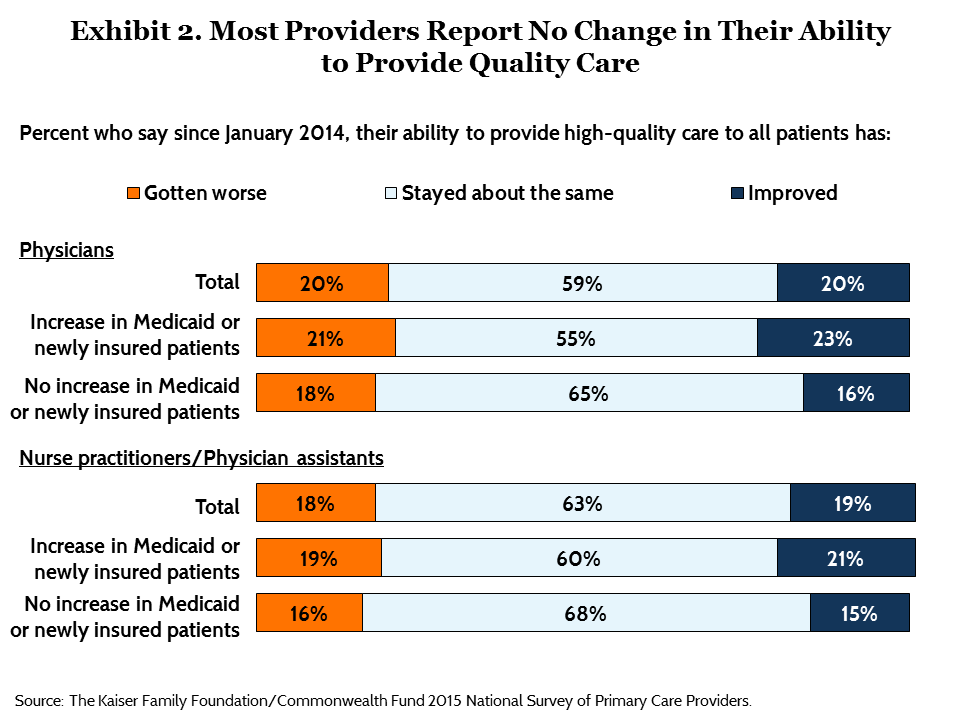
We examined whether providers who reported seeing an increase in Medicaid patients or newly covered patients are more likely than other providers to report changes since January 2014 in their ability to serve patients. Across several measures, the survey finds no relationship between reported changes to patient population and declines in practice capacity (Table 3). Among providers who have seen increases in the number of Medicaid patients or newly covered patients, most reported no changes since January 2014 in their ability to provide high-quality care to patients or in patients’ satisfaction and experiences with care.
One area of concern is the amount of time providers spend treating patients, compared with the amount of time spent on administrative or other tasks. Four of 10 physicians and more than a third of midlevel providers said the amount of time they have available to spend with each patient has gotten worse since January 2014 (Table 3). An even larger share—about six of 10 physicians and about half of nurse practitioners and physician assistants—said the amount of time they spend on administrative issues related to insurance has gotten worse. About three of 10 primary care physicians said they are somewhat or very dissatisfied with the amount of time they are able to spend with their patients (data not shown). In two surveys conducted by The Commonwealth Fund in 2006 and 2012—before the implementation of the ACA—about four of 10 physicians reported a similar level of dissatisfaction.2
Providers Say Most Patients Can Get Same- or Next-Day Appointments
Overall, about four of 10 primary care providers said almost all their patients who request a same- or next-day appointment can get one; another quarter said most of their patients can get such appointments (Table 4). For physicians, the rates are largely unchanged from 2009 and 2012—as measured by Commonwealth Fund surveys—suggesting that there has not been an overall decline in providers’ ability to provide timely appointments. The rates, however, are somewhat lower than those reported in 2006.3 Other surveys of patients also indicate that most adults with new coverage have been able to find physicians and get appointments within reasonable time frames.4
Physicians who have seen an increase in Medicaid patients or newly insured patients since January 2014 are less likely than others to say most of their patients can access a same- or next-day appointment (36% vs. 50%). However, it is not clear whether this difference is a direct result of increases in patient populations or whether it reflects a preexisting difference in practice capacity. For example, survey results show that of physicians working in community clinics—who are among the most likely to report an increase in Medicaid or newly insured patients—only two of 10 said almost all of their patients could get timely appointments (Table 4). This was also the case in 2012, before ACA reforms took effect.
Share of Physicians Accepting New Medicaid Patients Remains Unchanged from 2012
A large majority of primary care providers (83% of physicians, 93% of midlevel clinicians) said they are currently accepting new patients (Table 5). Nine percent of physicians said they stopped accepting new patients within the past 12 months; another 7 percent said they stopped accepting new patients more than one year ago (data not shown). Most primary care providers (71% of physicians, 80% of nurse practitioners and physician assistants) said they accept Medicaid, though fewer (50% of physicians, 66% of nurse practitioners and physician assistants) are currently accepting new Medicaid patients (Exhibit 3).
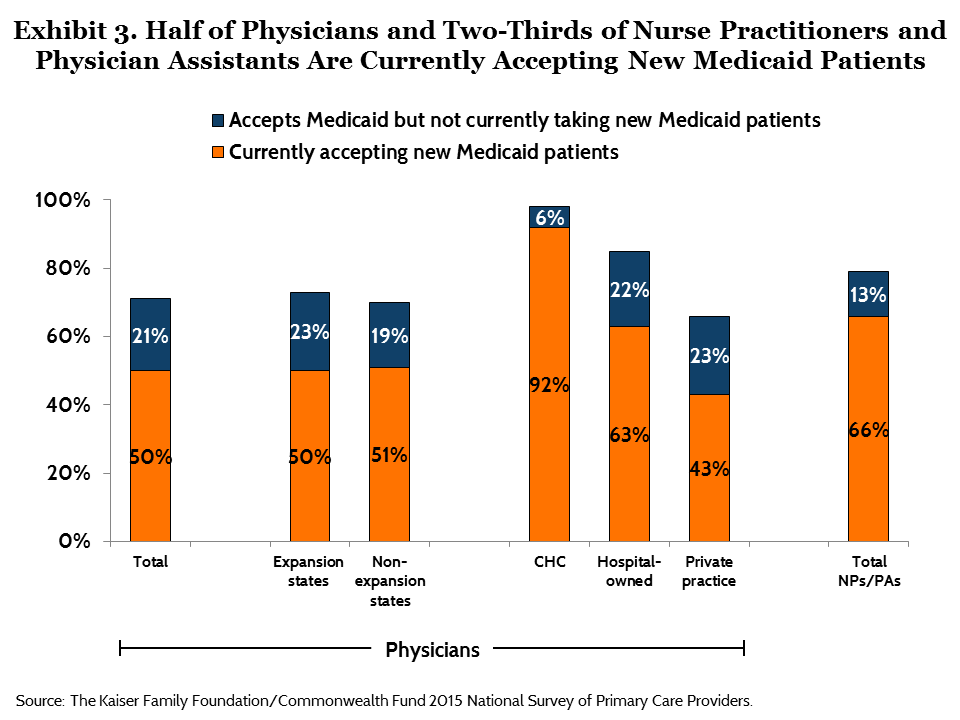
A survey conducted in late 2011 through early 2012 found that 89 percent of primary care physicians were accepting new patients and 52 percent were accepting new Medicaid patients.5 This indicates that while physicians’ rates of accepting new patients overall may have declined slightly since the ACA coverage expansions went into effect, acceptance rates for Medicaid have remained about the same. No similar trend data are available for nurse practitioners and physician assistants, but the current survey indicates that these practitioners are significantly more likely than physicians to be accepting new patients and particularly new Medicaid patients.
The share of providers accepting new Medicaid patients does not differ among physicians working in states that expanded their Medicaid program versus those that did not (50% and 51%, respectively) (Exhibit 3). However, there are certain types of primary care physicians who are more likely than others to say they are accepting new Medicaid patients: those working in community clinics (92%), those serving mostly low-income patients (82%), and those serving a higher proportion of non-English-speaking patients (74%) (Table 5).
PROVIDERS’ OPINIONS ABOUT HEALTH REFORM AND ITS IMPACT ON MEDICAL PRACTICE
Providers’ Opinions Split on ACA, with Sharp Divisions Along Party Lines
The survey asked providers about their views of the law and how it has affected their practice and patients. In contrast to the questions about their experiences over this time period, providers’ attitudes toward the law and their perceptions of its impacts break sharply along partisan lines.
Overall, primary care providers are about evenly split in their opinion of the Affordable Care Act, with about half saying they have a generally favorable view of the law and the other half unfavorable (Table 6). Similar to the general public, providers’ opinions divide sharply along partisan lines. Nearly nine of 10 of those who identify as Democrats have a favorable view of the law, while a similar share of Republicans said their view is unfavorable (Exhibit 4).

When asked more specifically about the expansion of Medicaid under the ACA, nearly four of 10 providers (36% of physicians and 39% of nurse practitioners and physician assistants) said the expansion has had a positive impact on providers’ ability to provide quality care to their patients (Table 7). About two of 10 said it has had a negative impact and the remainder said it has not made a difference or they are not sure. Providers who likely have more direct experience with the Medicaid expansion—that is, those who see a larger share of Medicaid patients and those working in expansion states—are more likely than their counterparts to say the impact of has been positive (Exhibit 5). Partisan divisions persist on views of Medicaid expansion, with majorities of Democrats viewing the impact as positive and most Republicans viewing it as neutral or negative (Exhibit 6).
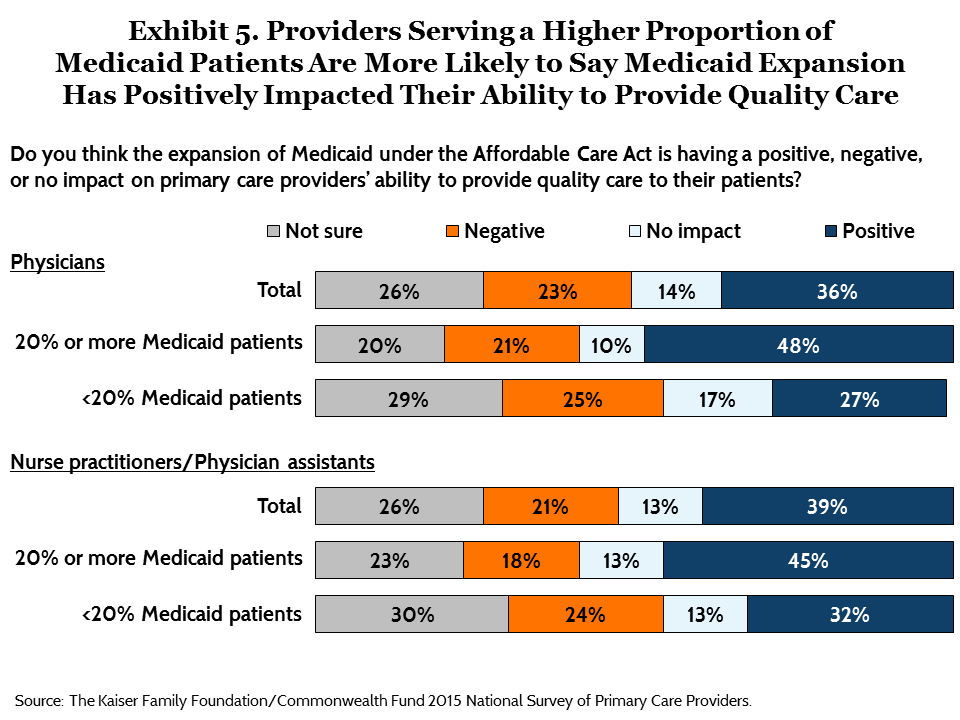
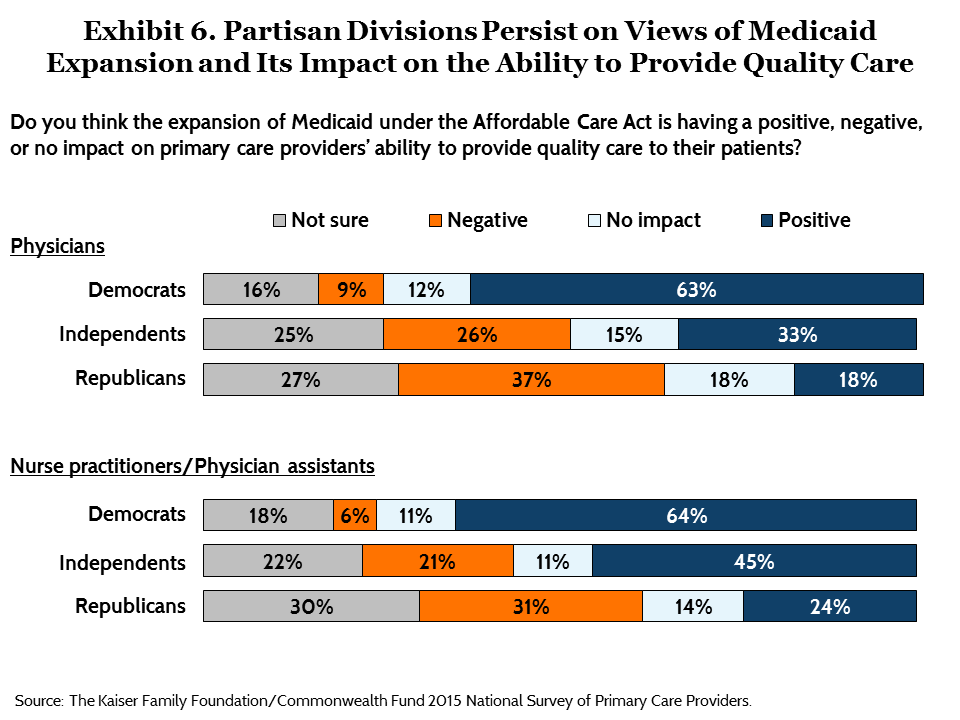
Partisanship Drives Differences in Perceptions of the Impact of the Affordable Care Act
Providers were asked five questions about whether the Affordable Care Act has had a positive, negative, or neutral impact on their practice (Exhibit 7, Table 8). When asked their opinions about the impact of the ACA on the quality of care their patients receive and on the ability of their practice to meet patient demand, between four of 10 and half of providers said there has been no impact. However, the share of physicians saying the impact in these areas has been negative is greater than the share saying it has been positive (Exhibit 7). About four of 10 providers believe the ACA has had a negative impact on patients’ out-of-pocket costs. Conversely, about half of providers said the ACA has had a positive impact on access to health care and insurance in the country overall.

Providers’ responses to the questions that mention the ACA by name are deeply divided along party lines. For example, by a three-to-one margin, physicians who identify as Democrats are more likely to say the ACA has had a positive (44%) rather than a negative (15%) impact on their medical practice overall (Table 8). Republican physicians break in the opposite direction by about seven-to-one (57% negative, 8% positive). Patterns of partisan divisions are similar among midlevel clinicians.
About half of providers (48 percent of physicians and 54 percent of nurse practitioners and physician assistants) feel they do not have enough information about the law to understand how it is affecting their medical practice. Similarly, 41 percent of Americans overall said they do not have enough information about the law to understand how it will affect them and their family.
Majority of Primary Care Providers Are Satisfied with Their Practice, But Many Are Pessimistic About the Future of Primary Care
Even though providers with different political affiliations do not share views about the Affordable Care Act, a large majority of primary care providers (83% of physicians and 93% of nurse practitioners and physician assistants)—both Republicans and Democrats—reported they are very or somewhat satisfied with their medical practice overall (Exhibit 8). The changing environment does not appear to be affecting overall provider satisfaction even among providers who see a larger share of Medicaid patients or work in Medicaid expansion states (Table 9). Indeed, current satisfaction levels are slightly higher than what was reported by primary care physicians before the ACA. In 2012, 68 percent of primary care physicians reported they were very satisfied or satisfied with practicing medicine.6
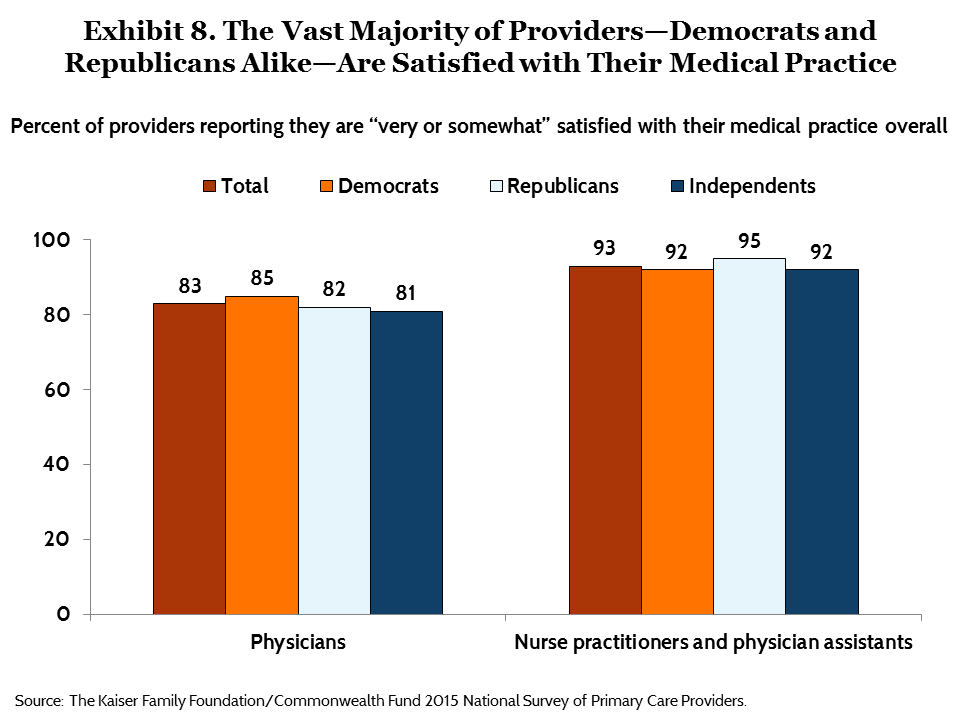
Still, many primary care physicians express pessimism about the future of primary care medicine (Table 9). Physicians are split on whether they would (45%) or would not (49%) advise a qualified high school or college student to pursue a career as a primary care physician. These views are somewhat divided along party lines, with Democrats (56%) more likely than Independents (40%) or Republicans (39%) to say they would recommend a career in primary care. Nurse practitioners and physician assistants are far more optimistic. The vast majority would recommend a career in primary care, whether Democrat (88%), Republican (89%), or Independent (79%).
Many Providers Unaware of Key Affordable Care Act Provisions
Even more than a year after the major coverage provisions went into effect, there is still a lack of awareness about the law among primary care providers (Table 10). For example, many providers are unaware of their own state’s Medicaid expansion status. When asked whether their state has expanded its Medicaid program, about six of 10 primary care providers (59 percent of physicians and 55 percent of nurse practitioners and physician assistants) answered correctly, while the remaining four of 10 either gave the incorrect answer or said they did not know. Providers in states that have expanded Medicaid are more likely to correctly identify their state’s status (62 percent of providers), compared with those in nonexpansion states (54 percent of physicians and 46 percent of nurse practitioners and physician assistants).
About half of providers are also unaware of specific reforms in the Affordable Care Act that are intended to encourage more providers to accept Medicaid and Medicare patients.7,8,9 For example, the ACA provided a 10 percent increase in Medicare payments to certain primary care providers from 2011 through 2015 to incentivize the provision of primary care and preventive services.10 A similar though shorter-lived program increased Medicaid payments for primary care physicians to match Medicare rates for 2013–2014 in an effort to maintain provider participation as the Medicaid population expanded.11 When asked whether they knew about these provisions or had received these payments, the survey found that among physicians who see Medicare and Medicaid patients, about half did not know about these bumps in payment (Table 10). Three of 10 physicians (31 percent) who see Medicaid patients reported receiving the Medicaid payment bump, and about half of those said it made a difference in their willingness to see these patients. Among physicians who accept Medicare, just one-quarter reported receiving the Medicare payment bump. Of these, about four of 10 said it made a difference in their ability to serve these patients, with most saying it made only a small difference. Most nurse practitioners and physician assistants serving Medicare and Medicaid patients were not aware of either of these payment increases (73% each).
CONCLUSION
The expansion of coverage to millions of previously uninsured Americans under the Affordable Care Act raised questions about how these changes would affect the primary care delivery system. This new survey finds that most primary care providers—including those who reported seeing more patients who are newly insured or covered by Medicaid—said their ability to provide high-quality care has not changed since January 2014. Most providers are not closing their practices to Medicaid patients. Large majorities of those who have traditionally been part of the Medicaid safety-net—including those working in community clinics and those serving a higher proportion of low-income and non-English-speaking patients—continue to say their practices are open to new Medicaid patients. Furthermore, a large majority of primary care providers say they are satisfied with their medical practices, although many physicians are pessimistic about the future of primary care.
However, the survey also finds that many primary care providers remain uninformed about aspects of the law. And despite their close connections to the health care system, primary care providers—like the public overall—view the law largely through a political lens.
Click here to download the tables.
| Contributors to this brief include Liz Hamel, Michelle Doty, Mira Norton, Jamie Ryan, Mollyann Brodie, Melinda Abrams, Rose Kleiman, and Anne-Marie Audet. |
MethodologyThe Kaiser Family Foundation/Commonwealth Fund 2015 National Survey of Primary Care Providers was jointly designed and analyzed by researchers at The Kaiser Family Foundation (KFF) and The Commonwealth Fund. Social Science Research Solutions (SSRS) carried out the field work and collaborated with Kaiser and Commonwealth Fund researchers on questionnaire design, pretesting, sample design, and weighting. The Kaiser Family Foundation and The Commonwealth Fund each contributed financing for the survey. The project team included Liz Hamel, Mira Norton, and Mollyann Brodie from KFF; and Michelle Doty, Jamie Ryan, Rose Kleiman, Melinda Abrams, and Anne-Marie Audet from The Commonwealth Fund. Survey responses were collected via hard copy and Web-based questionnaires between January 5 and March 30, 2015, with a random sample of 1,624 primary care physicians and a separate random sample of 366 nurse practitioners (NPs) and 159 physician assistants (PAs) working in primary care practices. The surveys achieved the following response rates, calculated using AAPOR’s RR3: physicians (34%), NPs (29%), and PAs (25%). The sample for physicians was procured from SK&A, which maintains a national database of physicians that is continuously updated by a telephone verification process. Physicians drawn for the sample were those whose specialty was listed in the SK&A database as either general practice, family practice, internal medicine, adolescent medicine, internal medicine pediatrics, general pediatrics, or geriatrics. Physicians were further screened to include only those who indicated in the survey that they spend at least 60 percent of their work time providing care to patients as a primary care provider. The physician sample included an oversample of physicians working in low-income areas (those whose office is located in a zip code where the average annual household income is $55,000 or less) and those working in federally qualified health centers and community health centers. The sample for NPs/PAs was procured from KM Lists, which uses publicly released data available from state licensing boards and information from professional associations and journal subscriptions to develop and update its database. Unlike physicians, specialty type for NPs and PAs does not necessarily correspond with the practice setting in which they work. Therefore, a broader list of specialties was included. NPs and PAs drawn for the sample were those whose specialty was listed in the database as family medicine, internal medicine, adult medicine, adolescent medicine, pediatrics, internal medicine pediatrics, geriatrics, preventive medicine, osteopathy, women’s health, or community/public health. The sample also included NPs and PAs whose specialty type was listed as “unknown” (these were undersampled relative to the other listed specialties). NPs and PAs were further screened to include only those who indicated in the survey that they are currently working in a primary care practice and that they spend at least 60 percent of their work time providing care to patients as a primary care provider. In an effort to maximize contact and completion rates, providers were contacted by multiple modes (mail, telephone, and email), offered incentives, and given the option of completing the survey in hard copy or online. A multistage weighting process was applied to ensure an accurate representation of the national population of primary care physicians and NPs/PAs. The first stage in weighting both samples involved corrections for sample design and differential nonresponse by email availability. Physician survey data were weighted by gender, age, specialty type, region, and site specialty using benchmarks in the 2014 American Medical Association Physicians Masterfile; and number of MDs at site using benchmarks in the SK&A list of primary care MDs. NP and PA data were weighted by gender and specialty type using benchmarks in the KM Lists. The physician sample was analyzed separately from the NP and PA sample. All statistical tests of significance account for the effect of weighting. The margin of sampling error (MOSE) including the design effect is plus or minus 3 percentage points for MDs and 5 percentage points for the combined group of NPs and PAs. Unweighted Ns and MOSE for NPs and PAs separately are shown in the table below. For results based on other subgroups, the MOSE may be higher.
|
Notes
1 Office of the Assistant Secretary for Planning and Evaluation, “Health Insurance Coverage and the Affordable Care Act” (Washington, D.C.: ASPE, May 5, 2015), available at http://aspe.hhs.gov/health/reports/2015/uninsured_change/ib_uninsured_change.pdf.
2 Authors’ analysis of the Commonwealth Fund International Health Policy Surveys (2006 and 2012).
3 Authors’ analysis of the Commonwealth Fund International Health Policy Surveys (2006, 2009, and 2012).
4 S. R. Collins, P. W. Rasmussen, and M. M. Doty, Gaining Ground: Americans’ Health Insurance Coverage and Access to Care After the Affordable Care Act’s First Open Enrollment Period (New York: The Commonwealth Fund, July 2014); and S. R. Collins, P. W. Rasmussen, M. M. Doty, and S. Beutel, Americans’ Experiences with Marketplace and Medicaid Coverage—Findings from the Commonwealth Fund Affordable Care Act Tracking Survey, March–May 2015 (New York: The Commonwealth Fund, June 2015).
5 Data from C. DesRoches, A.-M. Audet, M. Painter, and K. Donelan, 2011 National Survey of Physicians (New York: The Commonwealth Fund, 2011).
6 Authors’ analysis of the Commonwealth Fund International Health Policy Survey (2012).
7 S. L. Decker, “The Effect of Physician Reimbursement Levels on the Primary Care of Medicaid Patients,” Review of Economics of the Household, March 2007 5(1):95–112.
8 S. L. Decker, “In 2011 Nearly One-Third of Physicians Said They Would Not Accept New Medicaid Patients, But Rising Fees May Help,” Health Affairs, Aug. 2012 31(8):1673–79.
9 Medicaid and CHIP Payment and Access Commission, Report to Congress on Medicaid and CHIP (Washington, D.C.: MACPAC, 2015).
10 Medicare Payment Advisory Commission, Report to Congress: Medicare Payment Policy (Washington, D.C.: MedPAC, 2015).
11 Medicaid and CHIP Payment and Access Commission, Report to Congress on Medicaid and CHIP (Washington, D.C.: MACPAC, 2015).
